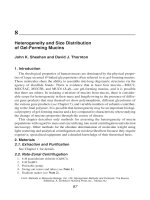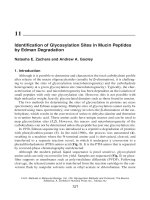Glycoprotein methods protocols - biotechnology 048-9-121-128.pdf
Bạn đang xem bản rút gọn của tài liệu. Xem và tải ngay bản đầy đủ của tài liệu tại đây (117.33 KB, 8 trang )
Sequencing Glycopeptides 121
121
From:
Methods in Molecular Biology, Vol. 125: Glycoprotein Methods and Protocols: The Mucins
Edited by: A. Corfield © Humana Press Inc., Totowa, NJ
11
Identification of Glycosylation Sites in Mucin Peptides
by Edman Degradation
Natasha E. Zachara and Andrew A. Gooley
1. Introduction
Although it is possible to determine and characterize the total carbohydrate profile
after release of the mucin oligosaccharides (usually by β-elimination), it is challeng-
ing to assign the sites of glycosylation (macroheterogeneity) and the carbohydrate
heterogeneity at a given glycosylation site (microheterogeneity). Typically, the char-
acterization of macro- and microheterogeneity has been dependent on the isolation of
small peptides with only one glycosylation site. However, this is not possible with
high molecular weight, heavily glycosylated domains such as those found in mucins.
The two methods for determining the sites of glycosylation in proteins are mass
spectrometry and Edman sequencing. Multiple sites of glycosylation cannot easily be
detected using mass spectrometry; one strategy involves the β-elimination of the car-
bohydrate, which results in the conversion of serine to dehydro-alanine and threonine
to α-amino butyric acid. These amino acids have unique masses and can be used to
map glycosylation sites (1,2). However, the macro- and microheterogeneity of the
carbohydrates can not be determined unless the peptide has just one glycosylation site.
In 1950, Edman sequencing was introduced as a repetitive degradation of proteins
with phenylisothiocyanate (3). In the mid-1960s, the process was automated (4),
resulting in a machine where the N-terminal amino acid is derivatized, cleaved, and
transferred to a separate reaction vessel, in which it undergoes a conversion to a
phenylthiohydantoin (PTH)-amino acid (Fig. 1). It is the PTH-amino that is separated
by reversed-phase chromatography and detected.
Although the modern pulsed liquid sequenator is pmol sensitive, glycosylated
amino acids are only recovered in low yield. Samples are sequenced (Fig. 1) on glass-
fiber supports or membranes such as polyvinylidene difluoride (PVDF). Following
cleavage, the released amino acid is transferred from the reaction cartridge to the con-
version flask by nonpolar solvents such as ethyl acetate or chlorobutane. The more
122 Zachara and Gooley
polar glycosylated amino acids are not soluble and remain in the support matrix (see
Fig. 1, vessel 1) and a blank cycle is observed in the sequencer.
An alternative approach is to use solid-phase sequencing to extract glycosylated
amino acids (5). Peptides and proteins are covalently attached to solid supports (6,7),
allowing the delivery of polar reagents such as trifluoroacetic acid (TFA) and metha-
nol, which facilitates the transfer of glycosylated amino acids. More importantly, it
has been shown that amino acids modified by different carbohydrates have different
retention times on high-performance liquid chromatography (HPLC) (8). Thus, for the
first time, both macro- and microheterogeneity can be determined for a glycopeptide
or glycoprotein in a single experiment (5). This technique has allowed mucin (and
mucin-like) glycopeptides and trifluoromethane sulfonic acid (TFMSA)-treated mu-
cin tandem repeats to be sequenced through the heavily glycosylated regions and the
macroheterogeneity to be assigned and quantitated (9–11).
Simple modifications to most modern sequenators facilitate the identification of
glycosylated amino acids (9,11,12). Although it is possible to identify amino acids
substituted with a monosaccharide using standard programs, the glycosylated amino
acids are not recovered quantitatively. Modifications of the transfer solvents to more
polar reagents, such as TFA or methanol, increase the recovery of glycosylated amino
acids modified by monosaccharides and larger oligosaccharides (degree of polymer-
ization [DP]=19). Elsewhere we have published alternative HPLC methods for the
separation of PTH-glycosylated amino acids on a modified Beckman LF3600
sequenator (12). These methods were developed for two reasons: (1) to provide a dis-
tinct elution window for the PTH-glycosylated amino acids, and (2) to be of low
enough salt concentration for the direct infusion of the PTH-glycosylated amino acid
Fig. 1. Edman degradation. Schematic version of Edman degradation in the modern
sequenator. (PITC, phenylisothiocyanate).
Sequencing Glycopeptides 123
into an electrospray ionisation mass spectrometer. However, the chromatography
described in ref. 12 is not commercially available and must be made in-house. The
following examples from the Hewlett Packard G1000A and the Procise™ from PE
Biosystems show HPLC separations (Fig. 2) of PTH-glycosylated amino acids
achieved with commercial kits.
2. Materials
2.1. Chemicals
1. Human Glycophorin A, blood type NN (Sigma, cat. no. G-9266).
2. Bovine κ-Casein glycopeptide (Sigma, cat. no. C-2728).
3. Sequencing grade TFA.
4. HPLC grade solvents, Milli Q water.
2.2. Reagents for Adsorption onto Hyperbond
1. Hyperbond membranes were from Beckman.
2.3. Protein Coupling to Arylamine Membranes (
see
Note 1)
1. Reagents are available in kit form from Beckman and PerSeptive Biosystems (MA; see
Note 2).
2. Milli Q water and analytical grade methanol are required for wash steps.
2.4. Edman Degradation
1. Reagents are obtained in the form of quality-assured sequencing kits, from the manufac-
turers of the sequenators.
2.5. Apparatus
1. Heating blocks at 80°C and 50°C.
2. Speed-Vac™ vacuum centrifuge (Savant Instruments, NY)
3. Beckman LF3600 protein sequenator, or Hewlett Packard G1000A protein sequencer, or
PE Biosystem’s Procise
™
.
3. Methods
3.1. Sample Preparation
Edman sequencing is a molar-dependent chemistry, and it is necessary to determine
how many moles of glycopeptide are to be sequenced (see Note 3). Samples for Edman
degradation (see Note 4) must be salt free and not contain sialic acid (see Note 5).
Samples can be electroblotted (see Note 6) or adsorbed onto Hyperbond or PVDF (see
Note 7), or covalently coupled to an arylamine-derivatized solid support (see Note 8).
For qualitative analysis of glycosylation sites, as little as 10 pmol of material is
required, whereas for quantification of the macro- and microheterogeneity, more
material is required, depending on the length of the peptide and the variation in the
structures present (see Note 9).
3.1.1. Desialylation of Glycopeptides
1. Place glycopeptide (5–50 pmol/µL) in salt-free buffer (up to 20% organic modifier [v/v])
in a screw-capped polypropylene Eppendorf tube.
124 Zachara and Gooley
Fig. 2. Glycosylated PTH-amino acid profiles. (A) The glycosylated amino acid window with the
elution profiles of PTH-threonine-GalNAc-Gal (black arrowheads) and PTH-threonine-GalNAc (gray
arrowheads) from Hewlett Packard G1000A protein sequencer. Standard amino acids are shown for
comparison (threonine, open arrowhead). These amino acids were separated using the manufacturer’s
suggested solvent system and program according to the Program 3.1 chemistry. (B) The glycosylated
amino acid window with the elution profiles of PTH-serine-GalNAc-Gal (black arrowheads) and PTH-
serine-GalNAc (gray arrowheads) from Hewlett Packard G1000A protein sequencer. Standard amino
acids are shown for comparison (serine, open arrowhead). These amino acids were separated using the
manufacturer’s suggested solvent system and program according to the 3.1 chemistry. (C) The
glycosylated amino acid window with elution profiles of PTH-threonine-GalNAc-Gal (black arrow-
heads) and PTH-threonine-GalNAc (gray arrowheads) from the Applied Biosystems Procise. Stan-
dard amino acids are shown for comparison (threonine, open arrowhead). These amino acids were
separated using the manufacturer’s suggested solvent system.
Sequencing Glycopeptides 125
2. Add an equal volume of 0.2 M TFA.
3. Incubate samples at 80°C for 30 min.
4. Remove TFA by lyophilization in a vacuum centrifuge (see Note 10).
5. Resuspend desialylated glycopeptide in 10–20% (v/v) acetonitrile.
3.1.2. Electroblotting
Glycopeptides can be desialylated before or after electrophoresis. Electro-
blotted glycopeptides are desialylated as in Subheading 3.1.1. with the follow-
ing precautions:
1. Prior to addition of TFA, place membranes in the reaction vessel and wet with 10 µL of
methanol.
2. Add enough 0.1 M (not 0.2 M as in Subheading 3.1.1.) TFA to cover the membrane.
3. Following incubation at 80°C, remove the membrane from the TFA, wash in Milli Q
water (three times) and dry.
3.1.3. Adsorption of Glycopeptides onto Hyperbond or PVDF
1. Place a piece of Hyperbond or PVDF (a round membrane is preferable, diameter ~0.5 cm;
see Note 11) in a lid of an Eppendorf tube and place on a hot plate at 50°C.
2. Wet with 10 µL of methanol.
3. When the excess methanol has evaporated, but before the membrane has dried, apply the
sample in 10-µL aliquots (see Note 12).
4. When all of the sample is applied dry the membrane.
3.1.4. Covalent Attachment of Glycopeptides
Glycopeptides are covalently attached to arylamine-derivatized membranes via the
activation of peptide carboxyl groups using water-soluble EDC (see Note 13). Cova-
lent coupling of the peptide to arylamine-derivatized membrane is as described in the
kit user’s guide.
1. Place an arylamine-derivatized membrane in an Eppendorf tube lid at 50°C.
2. Apply samples in 10-µL aliquots, allowing the membrane to come to near dryness between
each aliquot (see Note 14).
3. Dry the membrane after all of the sample has been applied.
4. Mix approx 1 mg of EDC in 50 µL of reagent attachment buffer (see Note 15) and care-
fully pipet 10–50 µL onto the arylamine-derivatized membrane.
5. Incubate the sample at 4°C for 30 min (see Note 16).
6. Wash the membrane alternately in 1 mL of methanol and 1 mL of Milli Q water three
times and dry.
3.2. Edman Sequencing
3.2.1. Glycopeptides Electroblotted or Adsorbed onto Hyperbond or PVDF
Glycopeptides adsorbed onto PVDF or Hyperbond can be sequenced with conven-
tional Edman degradation (Program 3.1 PVDF on the Hewlett Packard G1000A or the
PVDF routine for the blot cartridge on the Procise, or a modified program 40 recom-
mended by Beckman for PVDF on the Beckman LF series). While amino acids modi-
fied by monosaccharides will be identified, their recovery (as well as that of the larger
oligosaccharides) is not quantitative.









